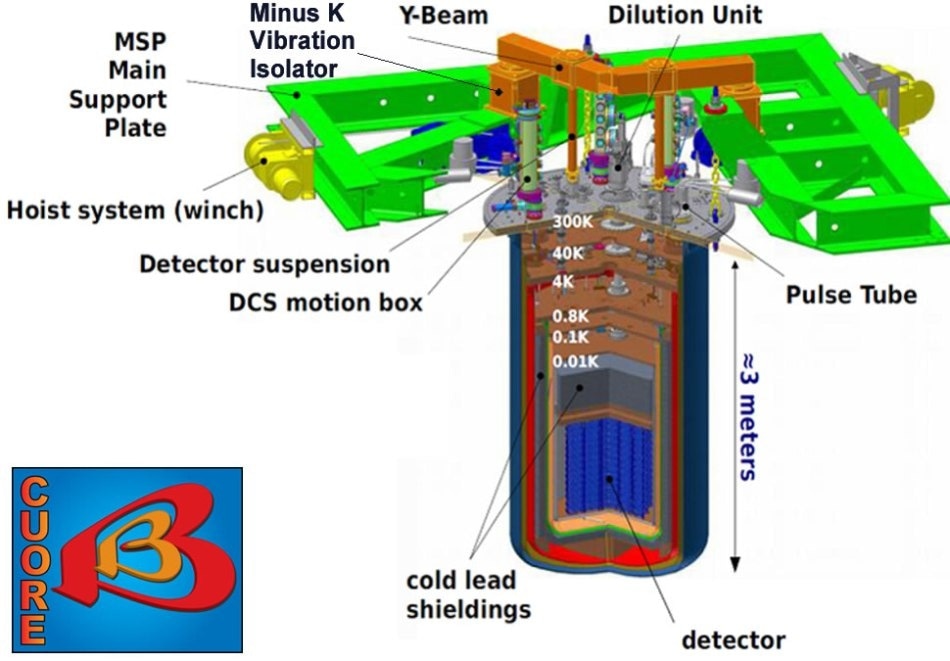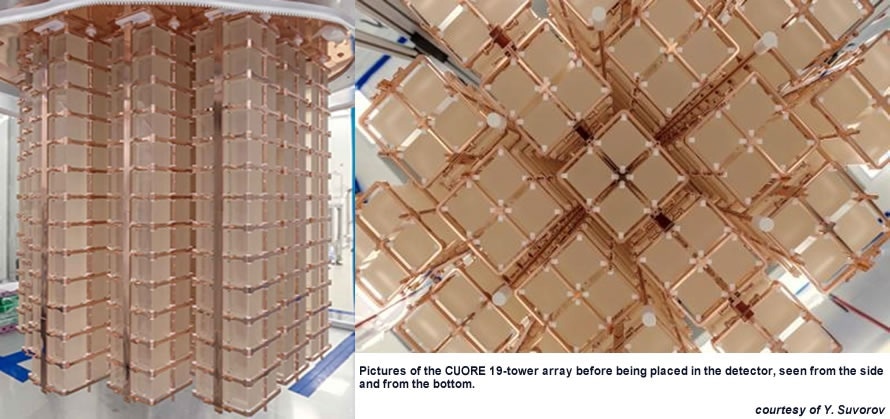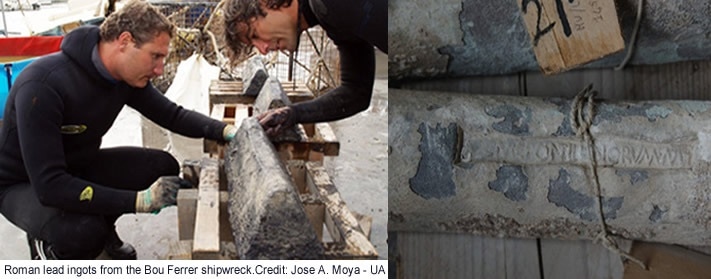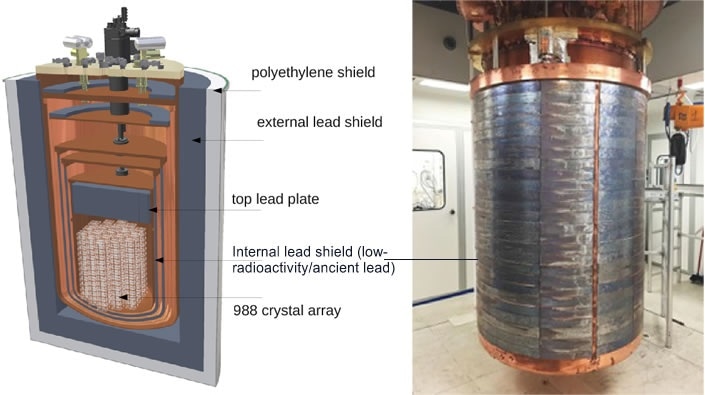As of January 2017, the CUORE detector is now capable of operating at a base temperature of 10 mK. This is over one ton of tellurium dioxide and copper cooled to a hundredth of a degree above absolute zero, making it the single coldest cubic meter in the universe.
CUORE Cryostat
The Cryogenic Underground Observatory for Rare Events (CUORE) is a 1 ton scale bolometric experiment that will study a property of ghostly neutrinos by searching for a phenomenon known as neutrinoless double beta decay. Exposing this process could be evidence as to why there is more matter than antimatter in the universe and reveal that neutrinos obtain their mass in a way that is different from all other particles.
In contrast to ordinary beta decays, in which electrons and antineutrinos share energy, the neutrinoless double beta decay creates two electrons, but no neutrinos at all. It is as if the two antineutrinos that should have been created overpower one another inside the nucleus.
The cryostat comprises of six nested vessels and shields. The three outermost ones are added in the outer Cryostat. Two of them (300 K and 4 K) are vacuum tight: the space between the 300 K and 4 K vessels establishes the Outer Vacuum Chamber (OVC) of the cryostat and the 300 K vessel functions at room temperature.
The volume within the 4 K vessel signifies the Inner Vacuum Chamber (IVC) and in regular running condition this vessel is thermalized to 4 K. Between the 300 K and 4 K vessel there is a thermal radiation shield at 40 K covered with a multi- layer aluminized superinsulation.
The whole cryostat is suspended from a heavy steel support structure, Main Support Plate (MSP) which holds the load of nearly 20 tons, specifically thermal shields and flanges (~8 tons), the detector (~1 ton) and the internal lead shielding (~10 tons).

The detector suspension has been engineered to reduce the transmission of mechanical vibrations both because of seismic noise and to the operation of cryocoolers and pumps. The suspension is a two stage low-frequency isolator fixed to a Y-beam above the cryostat, in the vertical direction, and a pendulum with a natural frequency of around 0.4 Hz, in the horizontal direction. It must offer load path for the detector while reducing the vibration transmission and the heat input.
The suspension is composed of three Minus K Negative-Stiffness vibration isolators and the Y-beam placed on top of them which is mounted on top of the Main Support Plate (MSP). The detector is suspended by the Y-beam via three composite rods. The system formed by the Minus K isolators and the rest of the detector will act like a spring-mass system with a cut-off frequency of 0.5 Hz. The composite rods are composed of several 316LN stainless steel rods, with three copper thermal links connecting to 40 K, 4 K and still plates. Also to lessen vibrational noise of the detector as much as possible there are autonomous suspensions for the dilution unit, vessels and detector.
The 0.5 Hz natural frequency Minus K isolators were tailored to include snubbers to restrict the maximum acceleration load from a severe earthquake to a tolerable level for the detector, says Dr. David Platus, President of Minus K Technology. “We simulated a 0.6 g earthquake (multiple times) to ensure that when supporting the detector the isolators reduced the force of an earthquake to well below the acceptable limits required by INFN.”
The installation of 19 "towers" that make up the detector was finished close to the end of August 2016.
All of the 19 towers that make up the detector, consisting of 988 Tellurium oxide crystals and weighing nearly 750 kg (1650 lbs), are now suspended from the coldest point of the experiment cryostat.
Oliviero Cremonesi, Spokesperson for the experiment

Avoiding radioactive contamination and protecting the experiment from external sources that might mimic the telltale energy signature CUORE is searching for is one priority. The mountains at Gran Sasso will provide one layer of shielding from cosmic showers, but the CUORE cryostat will also get a second layer of protection against the minor radiation from the mountain itself.
Lead is great at blocking radiation but contains tiny quantities of a radioactive isotope (lead-210) created by natural radioactivity which is universal on the earth. In recently mined metal, this isotope (which cannot be chemically separated from stable lead) is just starting to decay.
We could never use it for our experiment, which is exactly about keeping background radioactivity to a minimum.
Ettore Fiorini, Physicist, The University of Milan-Bicocca and Spokesperson Emeritus of the CUORE experiment
INFN received 270 Ancient Roman lead ingots, each weighing around 33 kg, from a Roman shipwreck that happened more than 2000 years ago (sank between 80 B.C. and 50 B.C.) off the coast of Sardinia, that have been made into a shield that will cover the crystal towers.
The Roman lead is pure, dense and much less radioactive, nearly all of the lead-210 has already decayed. The ingots have been at the bottom of the sea for two millennia but have been spared cosmic bombardment and offer very clean, if somewhat exotic, shielding material which is suitable for shielding sensitive experiments that search for dark matter and other rare particles.

With the historical importance, a number of archaeologists objected to melting down the 2,000 year old Roman ingots. The lead bars from the Bou Ferrer shipwreck were not merely melted down and recast. Rather, significant precautions were taken to lose as little information as possible.
First, only the majorly damaged ingots were designated for transfer to Italian National Institute for Nuclear Physics (INFN). All Roman lead bars include stamped characters identifying the smelter, the miner and frequently the mine from which the lead came. The material in which these symbols were stamped was taken away from the rest of the ingot, and stored for archaeological reference.
270 ingots were offered to INFN and a sizeable fraction has been employed for the CUORE construction. The lead ingots were cryoblasted to eliminate all surface contamination. This process, which does not cause radioactive contamination, consists of blitzing the surfaces with a pressurized stream of dry ice.
The ingots were then melted down to acquire the segments and panels needed to assemble a three centimeter thick lead lining shield that surrounds the cubic CUORE detector. This work, which was conducted at the German MTH Metall-Technik Halsbrücke GmbH & Co KG took over two months.

Conclusion
CUORE is the largest bolometric array ever attempted and the cryostat is the largest ever worked at a temperature of 10 mK. Designing and commissioning such a large cryostat was a challenge, a challenge increased by the requirement to use only low-radioactivity materials.
The CUORE cryostat was designed to surpass three key challenges: cooling down such a large mass to base temperature of 10 mK, decrease of vibrational noise transmitted to the detectors to guarantee a good energy resolution, and background reduction through stringent selection of cryostat materials.
CUORE is a partnership of more than 150 scientists mostly from institutions in Italy and the United States. CUORE is supported by the Istituto Nazionale di Fisica Nucleare (INFN), Yale University, the National Science Foundation (NSF), the US Department of Energy (DOE) Office of Science, the University of Wisconsin Foundation, the Alfred P. Sloan Foundation, and the National Energy Research Scientific Computing Center (NERSC).

This information has been sourced, reviewed and adapted from materials provided by Minus K Technology.
For more information on this source, please visit Minus K Technology.